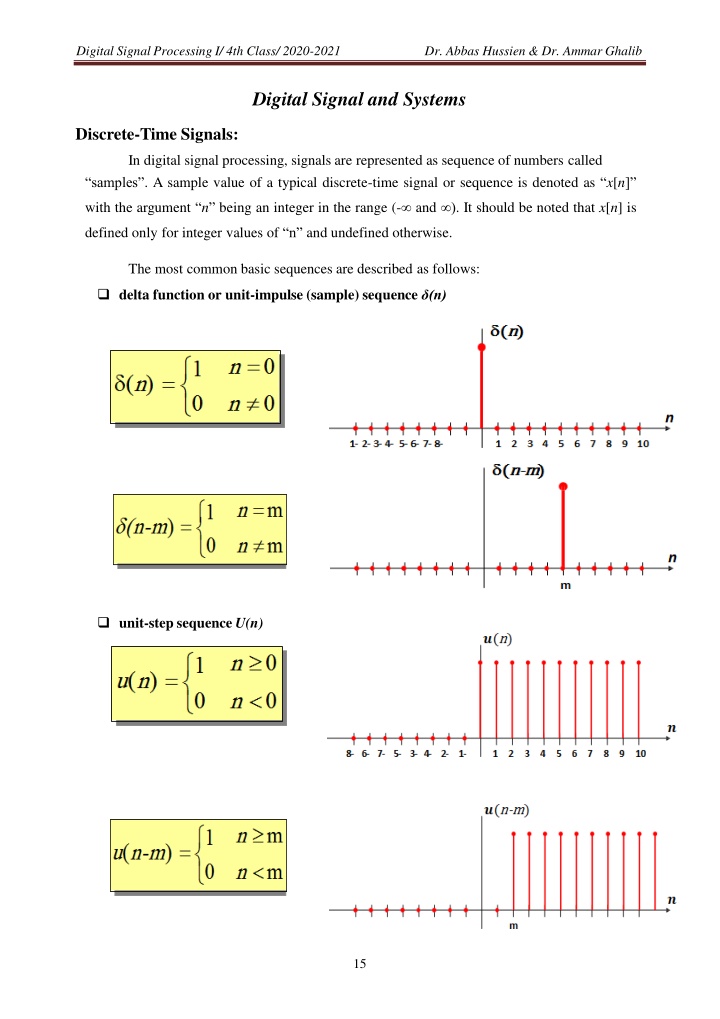
Digital Signal Processing and Sequences
Explore the fundamentals of digital signal processing, discrete-time signals, common signal sequences, conversions from analog to digital signals, periodic sequences, and operations on sequences. Learn about scaling, time shifting, reflection, and more in this informative guide.
Download Presentation

Please find below an Image/Link to download the presentation.
The content on the website is provided AS IS for your information and personal use only. It may not be sold, licensed, or shared on other websites without obtaining consent from the author. If you encounter any issues during the download, it is possible that the publisher has removed the file from their server.
You are allowed to download the files provided on this website for personal or commercial use, subject to the condition that they are used lawfully. All files are the property of their respective owners.
The content on the website is provided AS IS for your information and personal use only. It may not be sold, licensed, or shared on other websites without obtaining consent from the author.
E N D
Presentation Transcript
Digital Signal Processing I/ 4th Class/ 2020-2021 Dr. Abbas Hussien & Dr. Ammar Ghalib Digital Signal and Systems Discrete-Time Signals: In digital signal processing, signals are represented as sequence of numbers called samples . A sample value of a typical discrete-time signal or sequence is denoted as x[n] with the argument n being an integer in the range (- and ). It should be noted that x[n] is defined only for integer values of n and undefined otherwise. The most common basic sequences are described as follows: delta function or unit-impulse (sample) sequence (n) unit-step sequence U(n) 15
Digital Signal Processing I/ 4th Class/ 2020-2021 Dr. Abbas Hussien & Dr. Ammar Ghalib unit-ramp sequencer(n) exponential sequence x(n) = = Ae n If =0, x(n)=A If <0, x(n) is exponential decay. If 0, x(n) is exponential growth. Sinusoidalsequence x(n) = = x(t)t= =nT Note: s x(t)=sin(wt), the discrete sine x(n)=sin(wnTs) For analog sine w0=wTs where w=2 fm andTs=1/fs 16
Digital Signal Processing I/ 4th Class/ 2020-2021 Dr. Abbas Hussien & Dr. Ammar Ghalib Example: Assuming a DSP system with a sampling time interval of 125 microseconds, convert each of the following analog signals x(t) to the digital signal x(n). 1. 10 e 5000t u(t) 2. 10sin(2000 t)u(t) sol. 1. x(n)=x(nTs)= 10e 5000 0.000125nu(nTs ) = =10e 0.625nu(n) 2. x(n)=x(nTs)= 10sin(2000 0.000125n)u(nTs ) = =10sin(0.25 n)u(n) Periodic Sequences: A sequence x(n) is defined to be periodic with period N if Where; N is an integer number. Example: consider x(n) = = e jw0n x(n) = = ejw0n=ejw0(n+ + N)=ejw0Nejw0n= x(n + + N) w0 N = = 2 k N = = 2 k /w0 2 / w0 must be a rational number. Example: Is the sequence x(n) = = cos( n / 4) periodic. If yes, find N. sol. Suppose it is periodic sequence with period N x(n)=x(n+N) cos( n/4)=cos( (n+N)/4) n/4+2 k= n/4+ N/4 N=2 k/( /4)= 2 k/w0=8k K:integer for k=1, N=8 Example: Is the sequencex(n) = = cos(3 n / 8) periodic. If yes, find N. sol. Suppose it is periodic sequence with period N x(n)=x(n+N) cos(3 n/8)=cos(3 (n+N)/8) 3 n/8+2 k= 3 n/8+3 N/8 N=2 k/w0=2 k/(3 /8) K:integer for k=3, N=16 Example: Is the sequence x(n) = = cos(n) periodic. If yes, findN. sol. Suppose it is periodic sequence with period N x(n)=x(n+N) cos(n)=cos(n+N) Non-periodic sequence for n+2 k=n+N , There is no integerN K: integer 17
Digital Signal Processing I/ 4th Class/ 2020-2021 Dr. Abbas Hussien & Dr. Ammar Ghalib Operations on Sequences: For input signal x(n) and output signal y(n) (i) Scaling: y(n)= x(n) is called gain or scale factor. If | | 1, called an amplification. If | |<1, called an attenuating. If | |<0, called inverting. Sometimes denoted by triangle or circle in block diagram: (ii) Time shifting: y(n) = x(n n0) If n0 0, called delay. If n0<0, called predictor. (iii)Reflection (Time reversal): y(n) = x(-n) For multiple input signals x1(n) , x2(n) and output signal y(n) (i)Addition (summing): y(n)=x1+x2=x1(n)+x2(n) 18



















